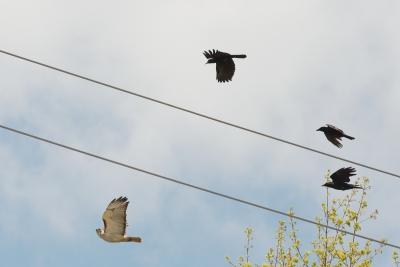
Mobbing behavior is an antipredator behavior which occurs when individuals of a certain species mob a predator by cooperatively attacking or harassing it, usually in order to protect their offspring. A simple definition of mobbing is an assemblage of individuals around a potentially dangerous predator. This is most frequently seen in avian species, though it is also known to occur in many other animals. While mobbing has evolved independently in many species, it only tends to be present in those whose young are frequently preyed on. This behavior may complement cryptic adaptations in the offspring themselves, such as camouflage and hiding. Mobbing calls may be used to summon nearby individuals to cooperate in the attack.
Birds that breed in colonies such as gulls are widely seen to attack intruders, including encroaching humans. Behavior includes flying about the intruder, dive bombing, loud squawking and defecating on the predator. Costs of mobbing behavior include the risk of engaging with predators, as well as energy expended in the process. Black-headed Gulls are one species which aggressively engages intruding predators, such as Carrion Crows. Classic experiments on this species by Hans Kruuk involved placing hen eggs at intervals from a nesting colony, and recording the percentage of successful predation events as well as the probability of the crow being subjected to mobbing. The results showed decreasing mobbing with increased distance from the nest, which was correlated with increased predation success. Mobbing may function by reducing the predator’s ability to locate nests, in other words as a distraction, since predators cannot focus on locating eggs while they are under direct attack.
Credit : Fandom
Picture Credit : Google




